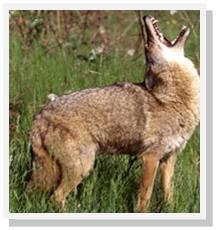
VIEW ON NATURE: Wily Invader
By: Stephen Wendt
 Just like the rest of the country, every county in Virginia has a relatively new, unwelcome wildlife resident…coyotes. Hailing from the southern and Midwestern plains states, coyotes are not native to Virginia. State biologists say they were first spotted west of the Blue Ridge in the 1950s and slowly infiltrated over the mountains across the entire commonwealth, including highly populated places like Hampton Roads and NOVA. I was doubtful coyotes had made it to my neighborhood until I caught a large male twice at dawn on a trail camera behind my house. These medium-sized, mostly nocturnal predators are smart at staying out of sight while clearly amongst us.
Just like the rest of the country, every county in Virginia has a relatively new, unwelcome wildlife resident…coyotes. Hailing from the southern and Midwestern plains states, coyotes are not native to Virginia. State biologists say they were first spotted west of the Blue Ridge in the 1950s and slowly infiltrated over the mountains across the entire commonwealth, including highly populated places like Hampton Roads and NOVA. I was doubtful coyotes had made it to my neighborhood until I caught a large male twice at dawn on a trail camera behind my house. These medium-sized, mostly nocturnal predators are smart at staying out of sight while clearly amongst us.
Coyotes in Virginia weigh between 30 and 45 pounds, although their full coats make them look larger. Their fluffy fur is often sandy brown but can vary from blondish to reddish-brown, grey or even black. Their bellies and throats are light colored; their bushy tails have a black tip and are held downward when running. Don’t confuse them with foxes or domestic dogs, they’re much larger than a fox and proportionally have longer legs than most dogs.
Coyotes are opportunistic omnivores. They eat just about anything from rodents, small game, wild turkeys and geese to deer fawns, carrion, fruits, berries, insects, amphibians, pet food, smaller livestock, and farm fowl and chickens. A friend told of a Shenandoah National Park trail camera recording two adult coyotes bringing over 20 whitetail fawns to their den in one spring alone! And in suburban/ urban areas with less wild game, coyotes have been known to take household dogs and cats (easily)!
They multiply like rabbits, often bearing five to seven pups between April and May. The pups emerge from the den in 2-3 weeks and often disperse in 6-9 months. Fairfax County says they may live as solitary individuals, in pairs, or in small family groups of a breeding alpha male and female and a few close relatives and new pups.
Coyotes are incredibly adaptable to almost any habitat and food. With the extermination of wolves and mountain lions, coyotes only have one predator (human hunters) which in northern Virginia means they pretty much have the rule of the roost as long as they avoid road traffic.
Attacks on humans by coyotes are very rare; more people are killed by wayward golf balls than bitten by coyotes. There were 367 attacks (lots in California) between 1977 and 2015; 40% of the victims were children under age 10. Most instances involved coyotes’ reacting to dogs, protecting their pups, or coyotes that have grown too accustomed to people or being fed.
If you suspect coyotes are about, take note of the following precautions:
¨ Never feed or attempt to “tame” a coyote
¨ Remove all pet food from outside
¨ Don’t leave your pets unattended during dim or night hours
¨ Place garbage in animal-proof containers on the mornings of trash pick-up
¨ Cover compost piles
¨ Keep ripe, fallen fruit from accumulating
¨ Minimize bird feeders that attract coyote prey
¨ Cover potential den site openings under porches, decks, sheds
¨ Keep coyotes wild and wary by scaring them away
¨ Don’t run from a coyote; stand your ground, make eye contact; yell, waive your arms
The best advice is to understand and avoid these wily invaders as you are very likely to encounter one.
(Copyright © 2012 Annandale Chamber of Commerce. All rights reserved. (Photographs & images, on this page, and on this website, are not available for use by other publications, blogs, individuals, websites, or social media sites.)
Copyright 2012 Annandale Chamber of Commerce. All rights reserved. Privacy Policy

